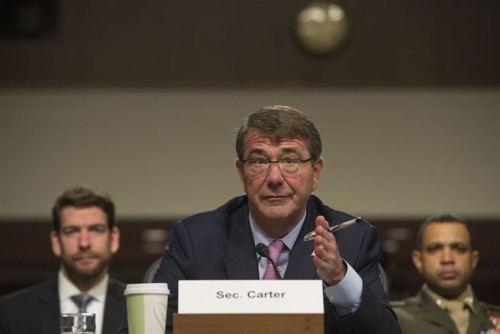Kampf gegen ISIS: USA wollen mehr Luftschläge und mehr Aktivität am Boden
Die USA wollen ihre Strategie im Kampf gegen die islamistischen ISIS-Milizen im Irak und in Syrien umstellen und dafür die Zahl der Luftschläge erhöhen – aber auch mit direkten Aktionen, vermutlich Spezialkräften, am Boden vorgehen. Den veränderten Ansatz machte US-Verteidigungsminister Ashton Carter am (heutigen) Dienstag in einer Stellungnahme vor dem Verteidigungsausschuss des US-Senats deutlich. Das Ziel: gather momentum, übersetzt etwa: wieder vorgeben, wo es langgeht.
Die wesentlichen Punkte aus Carters Statement:
The changes we’re pursuing can be described by what I call the “three R’s” – Raqqa, Ramadi, and Raids. Before I explain what they mean, let me also note that I took actions to streamline command-and-control of the counter-ISIL military campaign by assigning the entire effort to a single general officer, Lieutenant General Sean MacFarland, where in the urgency of the early phase of the campaign last year several layers were added to the general officer already present in Iraq.
The first R is Raqqa, ISIL’s stronghold and administrative capital. We have been clear for some time that we need to keep up pressure on Raqqa, and that to that end we will support moderate Syrian forces fighting ISIL that have made territorial gains near Raqqa – indeed, some of them are within 30 miles of Raqqa today. The Syrian Arab Coalition, which we plan to strengthen through our new equipping approach – more on that in a moment – will work over time with other Syrian anti-ISIL forces to push towards Raqqa. To the south, we plan to further strengthen our partner, Jordan. And from the skies above, we expect to intensify our air campaign, including with additional U.S. and coalition aircraft, to target ISIL with a higher and heavier rate of strikes. This will include more strikes against ISIL high-value targets as our intelligence improves; also its oil enterprise, which is a critical pillar of ISIL’s financial infrastructure. As I said last Friday, we’ve already begun to ramp up these deliberate strikes. (…)
The second “R” is Ramadi, the capital of Iraq’s Anbar province, which serves as a critical example of the Abadi government’s commitment to work with local Sunni communities with our help to retake and hold ground from ISIL and in turn to build momentum to eventually go northward to Mosul.
Under Prime Minister Abadi’s leadership, the Iraqis have begun to use American-made F-16s to support counter-ISIL operations, and have empowered capable battlefield commanders to step forward. As we see more progress towards assembling capable and motivated Iraqi forces under Baghdad’s control and including Sunni elements, we are willing to continue to provide more enabling capabilities and fire support to help them succeed. However, the Iraqi government and security forces will have to take certain steps militarily to make sure our progress sticks. (…)
The third and final “R” is raids, signaling that we won’t hold back from supporting capable partners in opportunistic attacks against ISIL, or conducting such missions directly, whether by strikes from the air or direct action on the ground. Last week’s rescue operation was led by Iraqi Kurdish forces, with U.S. advisers in support. (…) While our mission in Iraq is to train, advise, and assist our Iraqi partners, in situations such as that operation – where we have actionable intelligence and a capable partner force – we want to support our partners and we will.
Die ganze Stellungnahme hier.
Entscheidend wird natürlich die Umsetzung, und da kommt es auf die Details an. Zum Beispiel die angekündigten Luftangriffe auf ISIS-Hochwertziele – recht oft ist in den Lagemeldungen der US-geführten Operation Inherent Resolve von Luftschlägen gegen einzelne Fahrzeuge die Rede, mehr jedenfalls als von Angriffen auf strategisch bedeutsame Stellungen.
Deutschland ist auch Mitglied der Anti-ISIS-Allianz, und Verteidigungsministerin Ursula von der Leyen besucht in diesen Tagen die kurdischen Peshmerga-Kämpfer im Irak. Dort sagte sie den Kurden zwar weitere Unterstützung zu; was das im Einzelnen bedeutet, ist allerdings noch nicht so klar. Bereits vor Wochen erklärte die Bundesregierung, es werde geprüft, was an Waffen und Ausrüstung an die Kurden noch weiter geliefert werden könne. Was die Waffen angeht, scheint nach wie vor keine Entscheidung gefallen.
Nachtrag 28. Oktober: Reuters hat ein paar zusätzliche Informationen:
Two U.S. officials, who spoke to Reuters on condition of anonymity to discuss ongoing deliberations, said any deployments would be narrowly tailored, seeking to advance specific, limited military objectives in both Iraq and Syria.That option includes temporarily deploying some U.S. special operations forces inside of Syria to advise moderate Syrian opposition fighters for the first time and, potentially, to help call in U.S. air strikes, one official said.Other possibilities including sending a small number of Apache attack helicopters, and U.S. forces to operate them, to Iraq, as well as taking steps to bolster other Iraqi capabilities needed to claw back territory from Islamic State.
(Foto: Carter vor dem Senate Armed Services Committee – DoD photo by Air Force Senior Master Sgt. Adrian Cadiz)




Wen es interessiert. Lageentwicklung SY am Boden: https://bw2.link/UT15L
@Mitleser hatte am 05. November 2015 – 19:07 richtigerweise auf die Verlegung von F-15C/D der USAF in die Türkei hingewiesen, was auf den ersten Blick wenig Sinn zu machen scheint, da sie ein Luftüberlegenheitsjäger ist, dessen Wert gegen Daesh zunächst nicht erkennbar scheint.
In folgender Darstellung sind mögliche Gründe und Absichten betrachtet.
http://foxtrotalpha.jalopnik.com/usaf-f-15cs-deploy-to-turkey-under-curious-circumstance-1741114385?trending_test_a&utm_expid=66866090-62.H_y_0o51QhmMY_tue7bevQ.1&utm_source=dlvr.it&utm_medium=twitter&utm_referrer=https%3A%2F%2Ft.co%2Ffw4MkjemEx
Das deployment muss im Gesamtzusammenhang des Kriegsschauplatzes unter Zugrundelegung RUS Fähigkeiten/möglicher Absichten sowie der Diszlozierung von A-10 und C-130 spectre in Inçirlik gesehen werden [mal wieder Scharnhorst: das Ganze vor seinen Teilen … bewerten].
http://foxtrotalpha.jalopnik.com/this-photo-tour-of-the-usafs-grim-reapers-f-15-squadr-1739746754
Die F-15 C
– können den TUR Luftraum schützen und demonstrieren dadurch Bündnissolidarität
– es kann auch einer bloße Geste des Danks sein wegen Nutzung TUR Luftraumes
Konkreter darf Folgendes bewertet werden
– Schutz für B1-S, C-130 gunships und A-10, die kaum/nicht zum Eigenschutz befähigt sind
– Errichtung/Durchsetzung einer no-fly-zone über Nordsyrien zum Schutz der U.S.-gestützten Rebellen vor RUS Attacken
– counter air coverage für jüngst angekündigte vermehrte SOF- und erforderlichenfalls für CSAR-Heli Einsätze
– der offensichtliche IED-Angriff gegen den A-321 Metrojet Flight 9268 durch Daesh kann RUS veranlassen, eigene LuftOps nach Osten in das eigentliche Kalifatsgebiet zu verlagern. Den Eagles käme dann der Auftrag zu, die Operationsfreiheit der OIR-Kräfte durchzusetzen, denn dort operierten bislang OIR-Luftwaffen unangefochten ohne Gegnerbedrohung.
Gerade Letzteres hieße jedoch , dass die Eagles mehrheitlich außerhalb TUR Luftraums zu operieren hätten und de-conflicting mit den Russen „anspruchsvoller“ würde.
Die kommenden Tage werden Klarheit bringen.
Man interpretiert US Deltas zunehmend als menschliche Schutzschilde der PYD gegen TY Angriffe. Interessanter „Nebeneffekt“.
Danke an Thomas Melber fürs verlinkten von Offiziere.CH. Könnte dort eine Grafik finden die endlich mal die kurdischen Gruppierungen richtig aufschlüsselt: https://bw2.link/YVT4z
Neues/Altes von RU MOD für das Archiv: https://bw2.link/A8cIh
Arabische Partner der USA im Kampf gegen Daesh fahren ihr Engagement zurück.
http://m.spiegel.de/politik/ausland/a-1061706.html#spRedirectedFrom=www&referrrer=https://t.co/ZuNWR15bQT
Araber sehen die größere Bredrohung offenbar im Jemen, wohin sie ihre Jets verlegen/angreifen lassen: Dort geht es gegen Schiiten, Houthi + Iran. Da ist der sunnitische Daesh die kleinere Gefahr?
@ KPK: Da ist die Antwort. RU MOD redet über YEMEN (!) https://bw2.link/GxVO9
On October 6, Russian Deputy Minister of Defence Anatoly Antonov met UN Under-Secretary-General for Humanitarian Affairs and Emergency Relief Stephen O’Brien.
A frank and constructive exchange of views on the humanitarian situation in Syria and Yemen took place.
In the course of the meeting the parties discussed the importance of development of effective cooperation between Russia and the UN on the security of the UN humanitarian convoys.
Anatoly Antonov emphasized the necessity of usage of true information concerning the operation of the Russian Aerospace Forces against the militants of the “Islamic state” in the UN official documents on the humanitarian situation in Syria.
………………………………………………………………………………………………
Frage: Tritt RU nun offen als „neo-soviet“ Schutzmacht für den Iran und Damaskus auf? Wenn ja, ist dies die Erklärung für die F15C?
Was ihre Frage anbetrifft, sehe ich diese als – respektvollst – von rhetorischer Natur an. Bin schon zu oft zu Anthropoligie OT gegangen. Ich frage mich lediglich, ob es diplomatisch Knallt wie damals seitens J.F Kerry zu KSA, oder ob wir reinschlittern.
Der IRAN hat mit Putin den Ankauf von S-300 Flugabwehrflugkörpern vereinbart.
Gem Pressebüro Interfax hatte KSA sogar die Nachfolgeversion S-400 bestellt.
Die Aufrüstung im IRAN erhält angesichts der Stationierung von F-15 C/D in der Türkei eine Bedeutung (1), die einerseits unmittelbar mit der iranischen Unterstützung von Assad zusammenhängt, andererseits aber auch mit der Hilfe für die Houthi im Jemen, die sich saudischen Luftangriffen ausgesetzt sehen. S-300 ist mobil.
Vor diesem Hintergrund passt die Schutzmachtvariante von @Samir Awwad sehr gut ins Bild und wäre nichts weniger als nur konsequent.
http://www.telegraaf.nl/buitenland/24715508/__Iran_koopt_Russische_raketten__.html?utm_source=t.co&utm_medium=referral&utm_campaign=twitterfeed
(1) Mögliche Absicht der Stationierung von F-15C/D: 07. November 2015 – 10:23
Evtl. developing: China SY Luftangriffe.
Daesh Anschlag in Jordanien im Herzen der mil Basis der AT.
Israelische Luftwaffe greift Flugplatz Damaskus an.
Ziel, offenbare Waffenlieferungen für iranische Truppen, die auf Assads Seite kämpfen sowie für Hisbollah.
http://www.telegraaf.nl/buitenland/24728364/___Israel_bombardeert_Syrie___.html?utm_source=t.co&utm_medium=referral&utm_campaign=twitterfeed